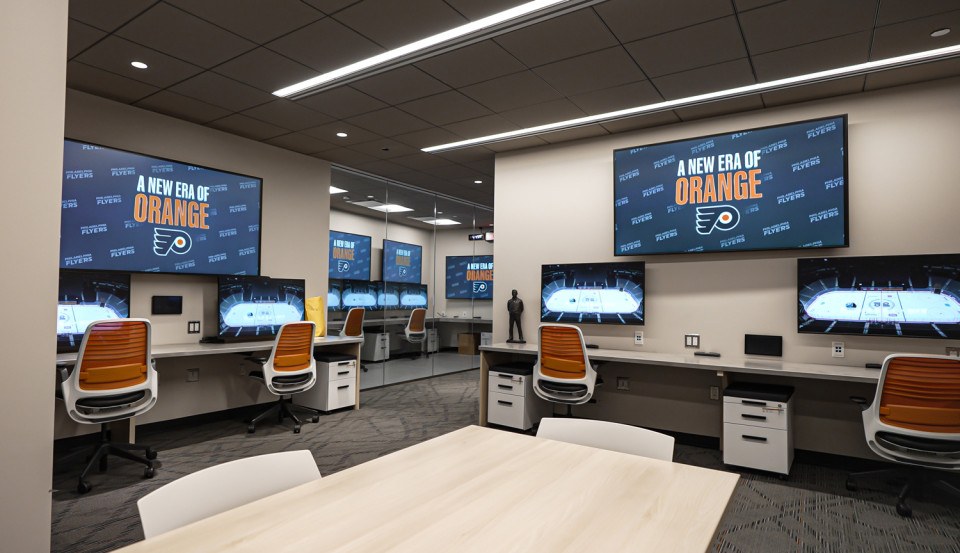Wells Fargo Center Unveils Upgrades Amid Arena Debate
The new locker rooms and behind-the-scenes areas are shiny and state-of-the-art, but will they be enough to keep the Sixers around?

The Flyers’ new locker room at Wells Fargo Center / Photograph courtesy of Comcast Spectacor
The question of whether the 76ers will build a downtown arena continues to be on everyone’s minds, with more community groups calling on City Council to block the project this week. To refresh your memory (or if you’ve been, say, without human contact for the past 15 months) the Sixers are looking to leave their current home at the Wells Fargo Center — owned by Comcast Spectacor, who also own the Flyers — and build their own arena in Market East.
Among the Sixers’ points of contention? Scheduling priority between the two teams (as well as concerts and other events at WFC), generally wanting to be their own landlords, and — perhaps most at issue —the player facilities, including locker rooms and training and medical resources, at their current home.
As the teams continue to hash it out in the court of public opinion, the Wells Fargo Center has been undergoing a massive $400 million “transformation” since 2016. We talked a little bit about fan-facing upgrades last week, but now we’re taking you underground to the Event Level to see how that much-contested territory has changed, and whether those changes might affect the larger Flyers-Sixers discussion.
The $30 million event-level renovation includes shared facilities for the Sixers and Flyers, including medical facilities, weight rooms, and lounges for visiting family (including a nursing space) and executives. “Things that it doesn’t make sense to duplicate” between the teams, Michael Sulkes, senior vice president and GM of Wells Fargo Center, tells me. But the shared spaces were “designed together.” The teams’ medical staffs, for example, worked together to create those shared facilities.

The new weight room shared by the Flyers and Sixers at Wells Fargo Center / Photograph by Laura Swartz

More event-level amenities / Photograph by Laura Swartz
The Sixers, Sulkes told me the day before the Flyers’ home opener, had already worked out in the shared weight room. Training space now has three times the footprint it used to take up.
Another feature you can’t help but notice throughout the event level: screens. There are big LED screens in every room, including the coaches’ suite’s “command center” that allows for video replay during and after games.

Command center for coaches at Wells Fargo Center / Photograph courtesy of Comcast Spectacor
“This has transformed a building into something that was built in 1995 to something that is state-of-the art,” Dan Hilferty, CEO of Comcast Spectacor, said during the tour of the new facilities.
Event-level renovations also include new locker rooms for both the Sixers and the Flyers. Unlike the spaces listed above, those were not collaborative.
The Flyers redid their own locker rooms, which include changing spaces for uniforms and gear and a secondary one for the players’ street clothes. Throughout that space, the team’s legacy is celebrated. After an orange-lit hallway, the locker room entryway has a monument to late founder Ed Snider, as well as the Flyers’ two Stanley Cups in a glass case.

The entryway to the Flyers’ new locker room honors the team’s legacy. / Photograph by Laura Swartz
After much back and forth, the 76ers put $10 million of their own money into their locker rooms, which were unveiled last spring for the playoffs. This summer, they worked on their coaching compound and players’ lounges. In their lease, the Sixers have complete control over their space.
But are these bright, shiny upgrades enough? The immediate answer would seem to be no, as the Sixers’ efforts to build 76 Place downtown have not let up. But that doesn’t mean Hilferty won’t stop trying to build bridges. When I talked to him this past summer, he stressed that he would “welcome an opportunity to create a 50-50 ownership” of the Wells Fargo Center with the Sixers, a partnership that could lay the foundation for the next chapter of their South Philly story. While the renovations expanded the lifespan of the Wells Fargo Center, he explained, “at the end of the lifespan, let’s build the next world-class arena, and let’s focus on looking at development opportunities right here on our existing property.”
When we spoke more recently, Hilferty hinted at an even more amenable timeline. “We’d like to work together to build a new arena, and we’d be willing to accelerate the timeframe to build that new arena right here in South Philadelphia.” The Sixers are under contract at Wells Fargo Center through 2031, so despite the $400 million renovations that give the arena new life, it seems that Comcast is not going to let sunk-cost fallacy get in the way of that potential partnership. “If we have to move up the timeline to make that happen, we’re more than happy to do it.”
To Hilferty, keeping the teams together in South Philly would be worth it: To him, ours is “the greatest sports district in America.” He envisions a more vibrant stadium district with more entertainment, dining and attractions — and he sees this future as brighter if the Sixers remain part of it. “The truth matter is [the Sixers] have a right to look at where they want to have their home and where they should build an arena … Regardless of what the Sixers do, we’re going to be there for them, but during this period of time, we’d like to paint a vision that may entice them to reconsider.”


